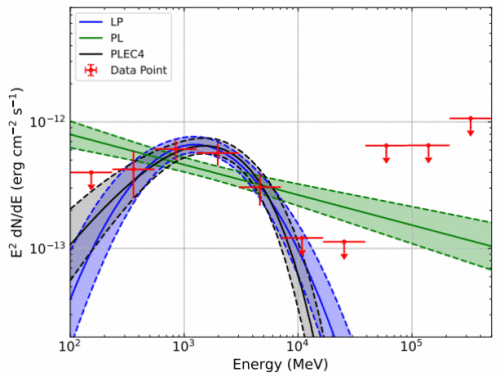Recently, a research on gamma-ray globular clusters (GCs), led by Prof. HOU Xian from Yunnan Observatories, the Chinese Academy of Sciences (CAS), with international collaborators from the Fermi-LAT gamma-ray telescope, Five-hundred-meter Aperture Spherical radio Telescope (FAST), and Arecibo radio telescopes, was published online in the Astrophysical Journal.
This research provides a detailed analysis of the gamma-ray emission of the GC M5, and has great significance for verifying the formation mechanism of millisecond pulsars (MSPs) in GCs and constraining the GC gamma-ray emission models.
GCs, the oldest and densest gravitationally bound star systems, have a higher abundance of low-mass X-ray binary (LMXB) and MSP systems compared to the Milky Way. The formation of LMXBs and MSPs in GCs, which is believed to be a result of frequent dynamical interactions between binary stars, shows a positive correlation with the binary encounter rate.
The Fermi-LAT has detected gamma rays from approximately 40 GCs to date. The leading model proposes that the gamma-ray emission from GCs is a collective contribution of MSPs within GCs. However, of the 305 GC radio pulsars, only three individual ones have shown gamma-ray pulsations. This is attributed to the vast distances of GCs, which make it possible to detect only the brightest pulsars in gamma rays, and to the challenge of obtaining precise ephemerides of GC pulsars to search for gamma-ray pulsations.
Observations from Arecibo and FAST have led to the detection of seven MSPs in the GC M5, with their precise ephemerides determined. The researchers found that the gamma-ray emission of M5 can be well described by an exponentially cutoff power law spectrum, which is consistent with that of MSPs. However, no gamma-ray pulsations were detected from these seven MSPs.
The researchers proposed two possible reasons for the nondetection of gamma-ray pulsations: the upper limits of the spin-down power of the seven MSPs are comparable with those of the Milky Way gamma-ray MSPs, indicating that their true spin-down power may be significantly lower than the upper limits, making them too weak to be detected; and the three GC gamma-ray MSPs are all located in GCs with high binary encounter rates. High encounter rates will destroy the LMXB systems, interrupt the accretion process, and result in slower pulsars that are only partially recycled with stronger magnetic field than Galactic MSPs, making them brighter. In contrast, M5's low encounter rate will produce fully recycled, fast-rotating MSPs similar to those in the Milky Way, while the GC's larger distance makes them harder to be detected.
Therefore, M5's gamma-ray emission comes from the collective radiation of the pulsars within M5. The team estimated that the number of MSPs in M5 is around 1-10, consistent with the number currently detected, suggesting that the sample of known MSPs in M5 is (nearly) complete.
"Although no individual gamma-ray MSPs have been detected in M5, the attempt to detect bright gamma-ray pulsars in low-encounter-rate GCs like M5 is a useful test.",said HOU Xian, the author of this article. "If a single bright gamma MSP is found in such GCs, its formation may not necessarily be related to processes that occur almost exclusively in high-encounter-rate GCs, such as the disruption of LMXBs." This work has added M5 to the list of well-studied GCs.
This work is co-sponsored by the National Key Research and Development Program of China, the National Natural Science Foundation of China, and the National SKA Program of China.

Figure 1, spectral fitting results for M5. The best-fit is the exponential cutoff power law (PLEC4) model. Image by HOU.
Contact:
HOU Xian
Yunnan Observatories, CAS
E-mail:xhou@ynao.ac.cn